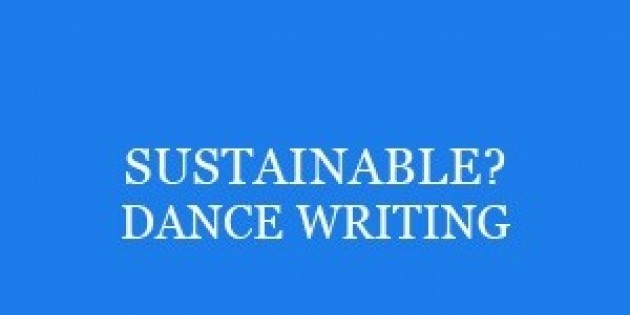Christine and Cory Comment -Solutions for Sustainable Dance Writing: A Town Hall Meeting at The Joyce Soho

April 12th, 2010 at Joyce SoHo
Features by:
Christine Jowers
I am allergic to panel discussions. All that sitting. All that talking. I trudged to the Town Hall meeting in the manner of a gourmand forced to eat wheat germ --very earnestly, because it is good for me, and because it is the responsible thing to do. ... Read More
Cory Nakasue
Few stones were left unturned in this discussion about the sustainability of dance writing, journalism, and criticism, but, unfortunately that is because we have had this talk before, and a new discussion needs to be broached; instead of talking sustainability maybe we should be talking about relevance. Who cares about dance? ... Read More
Christine Jowers
I am allergic to panel discussions. All that sitting. All that talking. I trudged to the Town Hall meeting in the manner of a gourmand forced to eat wheat germ --very earnestly, because it is good for me, and because it is the responsible thing to do. ... Read More
Cory Nakasue
Few stones were left unturned in this discussion about the sustainability of dance writing, journalism, and criticism, but, unfortunately that is because we have had this talk before, and a new discussion needs to be broached; instead of talking sustainability maybe we should be talking about relevance. Who cares about dance? ... Read More
2010 Christine Jowers, Editor, www.dance-enthusiast.com, Artistic Director www.movingartsprojects.org
Being a mover first and foremost, and a writer second (even when I write I have to dance about to figure out what words to use) I am allergic to panel discussions. All that sitting. All that talking. I trudged to the Town Hall meeting in the manner of a gourmand forced to eat wheat germ --very earnestly, because it is good for me, and because it is the responsible thing to do.
I was glad that I attended. In fact the panelists were wonderful even if somewhat battle fatigued. They included: Moderator Marc Kirschner, General Manager, TenduTV, Tonya Plank (of Swan Lake Samba Girl blog fame also a writer for Dance Explorer and The Huffington Post), Robert Johnson (Newark Star-Ledger dance writer & on Board of Directors the Dance Critics Association), Jaki Levy (Arrowroot Media, new media producer, online community builder, idea machine generator), Elizabeth Barry (Gendance, EB & Associates, a new dance marketer for the new generation) and Brian Mccormick (bmacmedia.net, Professor of Dance at The New School, Bessies Committee).
The depressing news we all know. Dance writing doesn’t pay. Traditional publications are disappearing. Robert Johnson figures he still has his job at The Star Ledger because the paper doesn’t understand exactly what he does. Last year most its arts writers left. Depressing. Of course this is terrible, but then again, welcome to the club, writers. Dancers spend a majority of their life creating and dancing without being paid or even acknowledged, some, in fact, paying to dance while they try to make ends meet with a hundred other jobs. I guess now we are all in the same boat. The only way to make life better for dance writers is to support ideas and actions that strengthen the dance community as a whole.
Marc Kirschner questioned the obligations of a dance writer, suggesting that it is necessary for a critic to keep an arms length from the community he writes about. Brian Mccormick who is the husband of choreographer Nicholas Leichter, in addition to being a writer and a teacher of criticism, challenged that idea. His involvement with the real struggle of a dance company is personal and perhaps gives him a sensitivity that is beneficial to his work. Personally, I think our field is in too much of a disaster zone for people to keep at arms length from one another. This is a time to pitch in and learn. I was really hopeful and excited to realize Mccormick teaches dance writing to young kids among his many jobs.
After listening to some of the audience writer complaints about having to dumb down their writing for publications, or being unable to review companies with short runs. I wonder, “perhaps losing the print forum isn’t necessarily a bad thing?” Maybe this change can actually free writers to do more of what they want--chutzpah, creativity and a dash of entrepreneurial business spirit required. This positive and possible opportunity vibe was shared by Jaki Levy.
Panelist Elizabeth Barry effervesced about sales and communication for the new generation. Zap. Boom. Pow. The most energized of all panelists, she zestfully encouraged every writer to create their own niche and develop their personal expert brand. For those who have trained to work in the arts appreciating the history, subtlety, process, and discovery, the slick brashness of “branding” coupled with the “less words --maybe even less dance?-- more pictures and video” adage can be off-putting, especially when couched in the phrase, “old people can be cool too.” It can certainly feel as if the packaging matters more than the substance. Still, I took out my mirror to check my packaging.
Bottom line, when dance becomes necessary to the public, writers will be required to help audiences learn and make discerning choices. My glass half –full theory is that there are dance enthusiasts everywhere; they just don’t know it yet. The question is: how are we going to tell them? Dance artists have been playing with new technological toys to promote their work, so have traditional media providers such as The New York Times and National Public Radio. Now it is our turn as individual dance-writers and communicators to pitch in. Can we get some help from universities with dance programs and presenters please? TenduTV is an exciting venue, and with the internet: blogs, podcasts, live -streaming, and creative thinking, there are multiple opportunities to reach new audiences, expose them to dance, make them hungry for more, and then, hopefully, get them to drop some serious cash so we can all get paid.
2010 Cory Nakasue, Writer, www.dance-enthusiast.com, Co-Artistic Director SPINE, www.spineart.com
This town hall was moderated by Marc Kirschner, General Manager, TenduTV. The panel included: Tonya Plank (Swan Lake Samba Girl), Robert Johnson (Newark Star-Ledger & Dance Critics Association), Jaki Levy (Arrow Root Media), Elizabeth Barry (Gendance, EB & Associates) and Brian McCormick (bmacmedia.net, The New School, Bessies Committee).
Few stones were left unturned in this discussion about the sustainability of dance writing, journalism, and criticism, but, unfortunately that is because we have had this talk before, and a new discussion needs to be broached; instead of talking sustainability maybe we should be talking about relevance. Who cares about dance?
We have all heard the horrific figures cited again and again, such as the number of full-time dance writers in the country (1), how the inches and pages relating to dance are dwindling from arts news sections and other publications, and how the blogosphere has turned into a murky free-for-all in terms of dance content. The problem doesn’t reside in the world of publishing (although the future of publishing in general is uncertain), marketing, or quality control (though, once there is an audience for dance writing, this issue should be on table.) The problem resides in audience development, the huge cultural shift away from live art, and demand—the problem resides in the dance “ecosystem” (a buzz-word of the evening along with “branding”).
Robert Johnson provided one of the most compelling arguments of the evening stating that the increasing suburbanization of America has created a population that cannot relate to urban culture. And, right now, suburban America is the largest consumer of information on the web and print media; a population whose dance appetites are sated by TV shows like “So You Think You Can Dance” and “Dancing with the Stars.” They are simply not interested in reading reviews of modern dance companies, much less an intellectual discourse of a post-modern aesthetic…for example. It has become irrelevant for most of the country. One writer in the audience who previously worked for a major publication claimed she was asked by editors to “dumb down” pieces of writing because a large part of their circulation wouldn’t understand it. It seems that dance has positioned itself in an elitist ghetto.
Another audience member commented on the insular nature of dance as a contributing factor and the short runs that most companies have in theaters, thus turning an already ephemeral art form into an art form that almost doesn’t even happen. Who will pay for writing about a non-event?
Moderator Mark Kirshner was teased throughout the evening for his capitalist take on the issue, but his pragmatism on the simple economics of supply and demand also put the responsibility back on the dance world to figure out how to grow its audience, or in this case consumers. Perhaps one of the funniest moments of the evening was when panelist Elizabeth Barry was trying to sell the legendary (and very vocal) Elizabeth Zimmer on branding herself, at one point exclaiming, “Old people are cool!” Herein lay the frisson of the evening; watching young marketers and web gurus try to consult with intellectuals and artists, especially those of another generation.
Bottom line: If there is no more dance writing, there will be no more dance. If we can turn this conversation into one about building audiences who are hungry for dance content, and making the art form more relevant to our culture, our writers will be compensated. I made not one peep during this town hall meeting, so, “peep.”














